Philips 47PFL6907T Review
Philips 47PFL6907T
Philips bids for fashion glory, but falls short in the picture department.
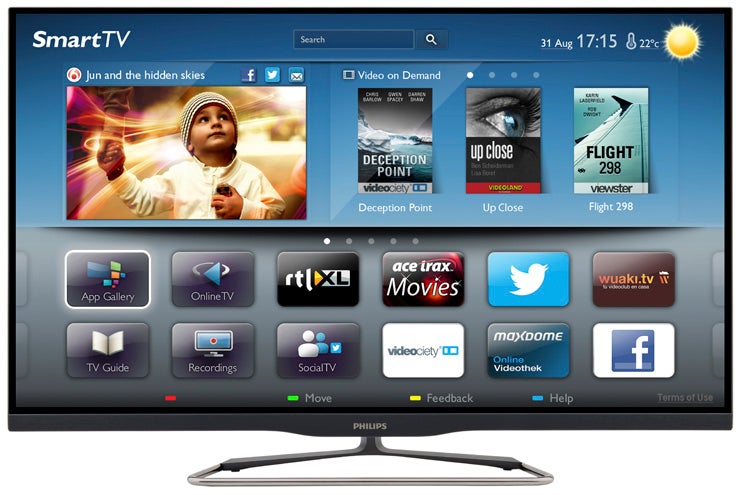
Verdict
Pros
- Very prettily designed
- Bright pictures look excellent
- Good sound quality
Cons
- High levels of input lag
- Significant backlight bleed with dark content
- Demanding operating system
Key Specifications
- Review Price: £999.00
- 47in LCD TV with edge LED lighting
- passive 3D with four pairs of glasses
- Pixel Precise HD processing
- Net TV online services
- Amiblight
Unusually for Philips’ latest TV range, the 47PFL6907 doesn’t get off on the right foot with us. Why? Because it’s told us a porky pie.
The thing is, Philips likes to describe the PFL6907’s design as ‘frameless’, backing this up with the suggestion that its metallic frame is only 1.2mm thick as well as promotional photos for the set that show the image on the screen appearing to run right up to this ultra-thin metal trim.
Philips 47PFL6907T – Design
As soon as you switch the 47in 47PFL6907 on, though, the frameless illusion is summarily shattered. For unless you’re watching something almost completely dark, you’ll immediately see that there’s a black border around 1cm across sitting between the image and the metal outer trim. So the 47PFL6907 isn’t really frameless at all where actual picture reproduction is concerned; it’s only frameless to the extent that the screen and inner black bezel are on the same level under a glass sheet and so you aren’t aware of the bezel while the TV is off. 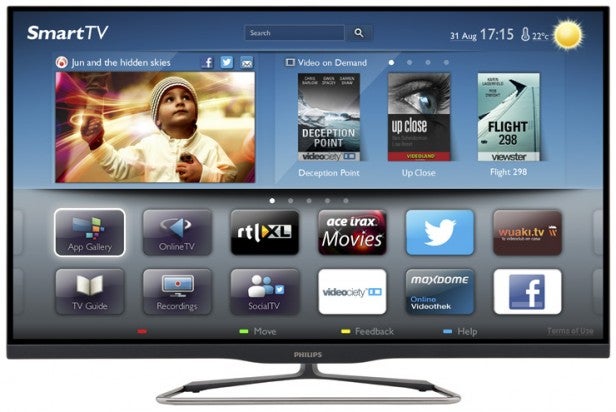
Trying to shrug off this disingenuous start, the 47PFL6907 is in fact a very attractive TV. The aluminium trim wraps right around the edge of and sits very nicely against the black inner frame; the glass-like top sheet across the front looks classy; and the build quality seems a cut above the norm. We also lapped up the brushed metal look to the TV’s wider bottom edge. We just wish the TV’s core design wasn’t claiming to be something it’s not.
Philips 47PFL6907T – Ambilight
The 47PFL6907’s design doesn’t actually stop at that aluminium trim. For it’s got a cute glinting stand and also, courtesy of Philips’ Ambilight technology, it can produce pools of coloured light around its left and right sides that can match the colour content of the images you’re watching.
This is a much more likable and useful tool than it sounds, as it makes long-term viewing less fatiguing and the viewing experience more immersive. One ironic thing about Ambilight, though, is that it tends to highlight that unfortunate black ‘inner frame’ Philips doesn’t want you to know about…
Spec differences
Moving on to other matters, a good place to start is to hunt for specification differences (aside from the obvious design one) between the 47PFL6907 and the slightly cheaper PFL6007 series. The one that most jumps out is its ‘600Hz’ Perfect Motion Rate (PMR) motion handling system rather than the 400Hz on the PFL6007s. But it also sneaks in a slightly more powerful 2 x 12W audio performance (with the aid of a rear-mounted woofer to take the bass pressure off the other speakers).
Philips 47PFL6907T – Connectivity
Connectivity is the same. Which isn’t a bad thing, as for its lower-mid position in Philips’ range it’s surprisingly flexible thanks to its ‘big hitters’ of four HDMIs, three USBs and built-in Wi-Fi.
The USBs support recording from the built-in Freeview HD tuner or playback of a strong variety of photo, music and video file types, while the Wi-Fi (and a LAN port if you’d rather) will either access multimedia files stored on a DLNA PC or take you online with Philips’ Net TV service.
We’ve covered this service in other recent Philips TV reviews, so here we’ll just restrict ourselves to pointing out its main highlights – the BBC iPlayer, YouTube, AceTrax, Twitter, Facebook and the recently added BlinkBox – while adding that a few more video services like Netflix and LoveFilm would be very welcome.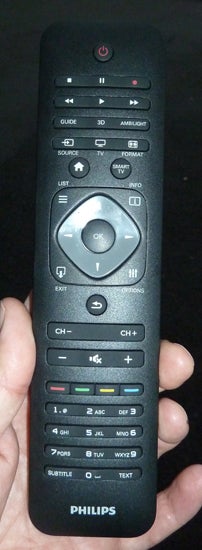
As a quick aside, we should add that the 47PFL6907 doesn’t have the QWERTY keyboard on the rear of the remote that you get on the PFL7007 and higher models.
One accessory you do get, though, is 3D glasses. In fact you get four pairs, to support the 47PFL6907’s passive 3D talents (called Easy 3D by Philips).
Philips 47PFL6907T – Picture processing
The last thing to mention about the 47PFL6907’s specification is that it carries Philips’ Pixel Precise HD processing system. This isn’t Philips’ most powerful system; that’s reserved for the PFL8007 and PFL9707 series models. But it’s still very potent indeed for a 47in 3D TV that’s on sale for less than £1,000.
It has elements that focus on pretty much every aspect of picture quality, and although it might initially seem like a chore, we strongly recommend that you familiarise yourself with all the processing options provided in the lengthy (and slightly tortuous) onscreen menus. For knowing when and how strongly to use tools like noise reduction and motion processing is key to continually getting the optimal performance out of the 47PFL6907.
Having been consistently impressed by the performance of Philips’ latest spate of 2012 TVs, the 47PFL6907 turns out to be a disappointment – if only really for one solitary but massive reason: backlight bleed.
While watching any dark material on the 47PFL6907, we routinely spotted two jets of light pouring down the picture from the left and right end of the top edge. Such backlight ‘bleed’ is by no means rare in the edge-LED world, but the jets of light shooting into the picture on the 47PFL6907 are both larger and more pronounced than we commonly see these days. At times the effect is akin to two people shining torches down the picture from the sides.
Distracting stuff
Needless to say, this can seriously distract you from any dark scene – especially if that dark scene has a bright element near its centre, as this really raises the brightness level of the incoming light seepage.
Its impact is also exaggerated while watching any wide aspect ratio films thanks to the black bar that sits above the picture.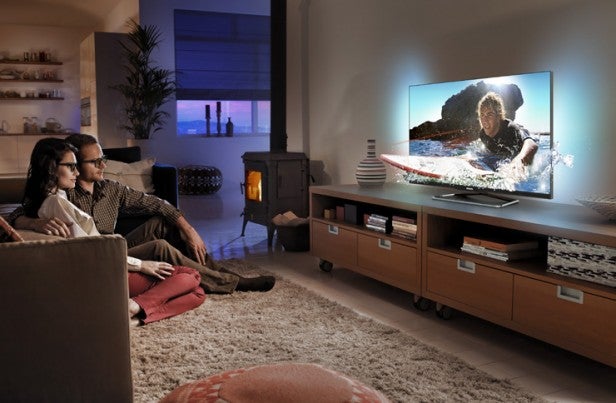
With some TVs it’s possible to calibrate images – usually by reducing the backlight output – so that initially distracting levels of backlight inconsistency are removed. We really struggled to find a way of getting rid of the problem on the 47PFL6907, though. The Backlight Contrast option doesn’t really do anything much to it, while reducing the brightness just bleeds the life out of the picture behind the backlight leaks rather than taking the heat out of the light pools.
Dynamic backlight helps – a bit…
The only thing that makes a significant difference is the set’s Dynamic Backlight option, where the picture adjusts its contrast automatically in response to the picture content. But while activating the dynamic backlight can reduce the impact of the light seepage during nearly uniformly dark scenes, as soon as the image has any bright content in it the dynamic backlight options can actually exaggerate the flaw, as you keep seeing large variances in the amount of light clouding apparent in the offending corners.
To put a little positive perspective on the backlight clouding, you hardly ever notice its existence if you’re watching anything at all bright and colourful – the sort of content, in fact, which makes up the majority of a typical household’s viewing. You are also far less aware of it even during dark scenes if your room is brightly lit. So if you’re not the sort of person who likes to dim the lights for serious film viewing from time to time, the backlight clouds might not cost you any sleep.
For us as both movie fans and testers of TV technology, though, the backlight inconsistency is impossible to ignore, and thus hard to live with.
Unwanted pulse
The fact that the best way to reduce the impact of the backlight clouding is to use the dynamic backlight system introduces another problem too. For as with the 40PFL7007T we tested recently, the dynamic backlight can cause a sporadic problem with some (especially animated) content where abrupt shifts from quite dark to very bright shots cause a brief but still noticeable horizontal pulsing/flickering effect over the central third or so of the picture. 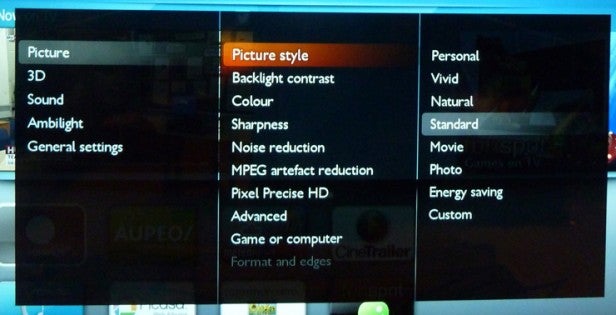
This happens least often if you stick with the Standard dynamic backlight setting rather than the ‘best for power’ or ‘best for picture’ options. And it disappears entirely if you turn the dynamic backlight off. But as we said, because of the backlight flaws, turning the dynamic backlight off is less of an option on the 47PFL6907 than it was on the 40PFL7007T.
Positive thinking
So far we’ve been pretty hard on the 47PFL6907, so it’s high time we introduced some positivity. For in fact, when very dark scenes and rooms aren’t exposing the backlight problem, its pictures vary between very good and outstanding.
The outstanding moments come with good quality bright HD sources. Detail and sharpness levels with HD content are truly startling, making the HD efforts of many rivals look soft by comparison. This is especially true if you’ve got the TV’s Advanced Sharpness system active, which somehow manages to make HD images look like they’re being mapped on to a pixel count higher than 1920×1080.
Handle advanced sharpness feature with care
We’re not necessarily recommending that you use the Advanced Sharpness system, mind you; it can cause pictures to look a bit fizzy – especially if they already contain a lot of grain – as well as making object edges look stressy. And anyway, even without the system, pictures still look absolutely pin sharp.
Helping this happen is the 47PFL6907’s handling of motion, as there’s only relatively little evidence of judder or LCD’s infamous resolution loss and blurring problems. In this respect pictures look slightly cleaner than those of the cheaper 6007T series.
If you employ Philips’ Perfect Natural Motion processor you can remove all the judder and blur from pictures. This system doesn’t work quite as effectively on the 47PFL6907 as it does on those higher end Philips TVs that use the brand’s flagship Perfect Pixel HD processing engine, but it’s still worth experimenting with on some sources – especially broadcast ones – even if you’re probably best only using it on its lowest power setting.
Personally we wouldn’t use the Natural Motion system while watching HD films, especially in 3D, as with this sort of content you’re much more likely to notice motion processing glitches like flickering and lag.
Good contrast
Despite the backlight clouds at the top, meanwhile, the 47PFL6907 actually delivers a pretty competent contrast performance, producing deep blacks without removing too much brightness from the image. Shadow detailing isn’t bad either where the backlight clouds aren’t in the way – a situation helped by the screen’s surprisingly strong ability at soaking up reflections from your room.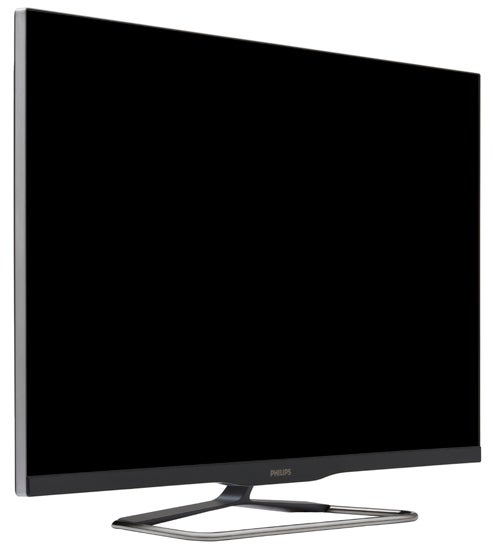
Colours are vibrant and punchy, but also enjoy plenty of finesse and a good range of tones. There’s not quite such a high-end feel to colour reproduction as you get with the PFL7007T series, but overall colours still look terrific for the 47PFL6907T’s price.
3D performance
The 47PFL6907T is also great fun to watch in 3D. Its use of passive technology means you don’t have to worry about flickering if you’re watching in a bright room, or the sort of crosstalk ghosting noise common with active 3D technology.
There’s also practically no loss of brightness or colour vibrancy in 3D mode, compared with the quite heavy hit both these picture aspects can take with some active 3D systems. Finally in the plus column, the sense of depth in the 47PFL6907T’s pictures feels natural and the whole viewing experience feels much less tiring.
3D Weaknesses
The reasonably large 47in screen on the 47PFL6907T does also reveal passive 3D’s weaknesses of ‘striping’ over the edges of small or contoured objects; a small reduction in detail levels; and the occasional bit of visible horizontal line structure.
The biggest problem, though, is the way the backlight clouds at the top of the picture described earlier appear to ‘lie across the top’ of dark 3D scenes, disrupting the 3D effect. This will likely infuriate picture enthusiasts.
Nonethelss, for a typical family environment, the 47PFL6907T’s practical 3D appeal and its quality with bright, colourful material is undeniable.
Up next on our check list is standard definition. The 47PFL6907T does well here in two respects, as its powerful processing makes SD sources look sharper and more detailed while also retaining more colour punch and credibility than you see with some TV upscaling engines. The only issue is that standard def images on the 47PFL6907T can look a little noisy unless you use the noise reduction tools. Yet these tools can make the picture look rather soft.
Overall, though, the 47PFL6907T is a perfectly solid standard def upscaler for those thankfully now rare moments where you can’t watch HD.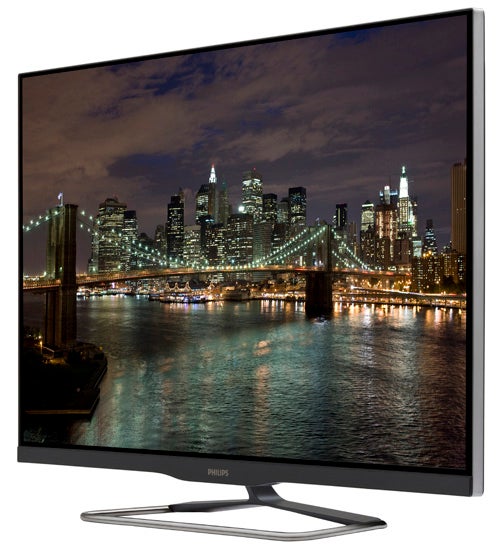
The 47PFL6907T sadly has one last picture weakness to reveal before we’re done, though. For running our usual input lag test records a seriously high figure of more than 130ms, even when using the TV’s Game/Computer modes. High input lag figures are disappointingly common with TVs built around LG’s passive 3D technology, but the figure recorded on the 47PFL6907T is the highest we’ve seen in 2012, and makes it a seriously compromised option for gaming on.
We’re able to wrap up on a more positive note with the 47PFL6907T’s audio, which is excellent for such a slim TV. A woofer on the set’s rear helps it produce a much wider, more powerful mid-range in which the set can handle vocals, treble details and even a modicum of bass without sounding cramped or harsh.
The soundstage isn’t the widest, perhaps, but it’s certainly cohesive and engaging, allowing you to be immersed in the action much more effectively than the audio performances of most skinny TVs.
Verdict
The 47PFL6907T is Philips’ first and hopefully only stumble with its current TV range. To be fair, much of the usual Philips quality is there for large chunks of your viewing time, and the TV looks gorgeous so long as you don’t expect it to live up to Philips’ ‘frameless’ claims.
But the severity of the backlight bleed plus the lag issues film and gaming fans will regularly be faced with on the 47PFL6907T means we’d recommend that Philips fans instead step down to the PFL6007 series or, preferably, up to the PFL7007T range instead.
How we test televisions
We test every TV we review thoroughly over an extended period of time. We use industry standard tests to compare features properly. We’ll always tell you what we find. We never, ever, accept money to review a product.
Trusted Score
Score in detail
-
Features 9
-
3D Quality 7
-
Value 7
-
Design 9
-
2D Quality 6
-
Sound Quality 9
Features
| Size (Inch) | 47in |
| Display Type | LED |
| Max. Resolution | 1920 x 1080 |
| Full HD 1080p | Yes |
| Digital Tuner | Yes |
| Freeview HD | Yes |
| Freesat HD | No |
| 3D Ready | Yes |
| Contrast Ratio | 500,000:1 |
| Refresh Rate (Hertz) | 600Hz |
Connectivity
| HDMI | 4 (v1.4) |
| Component | 1 |
| Composite | 1 |
| Scart | 1 (RGB) |
| Digital Audio Out | 1 (optical) |
| Headphone | 1 |
| Ethernet | Yes |
| WiFi | Yes (built-in) |
Physical Specifications
| Height (Millimeter) | 640mm |
| Width (Millimeter) | 1066mm |
| Depth (Millimeter) | 35.3mm |
| Weight (Gram) | 15g |

